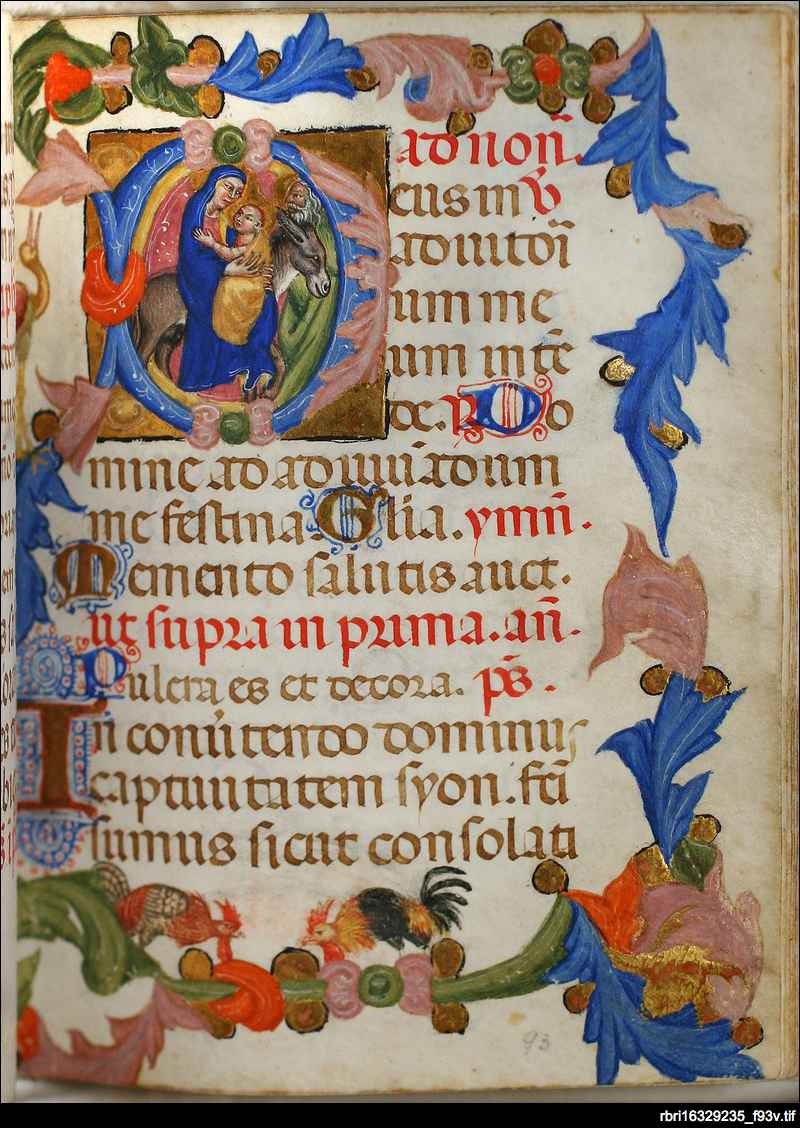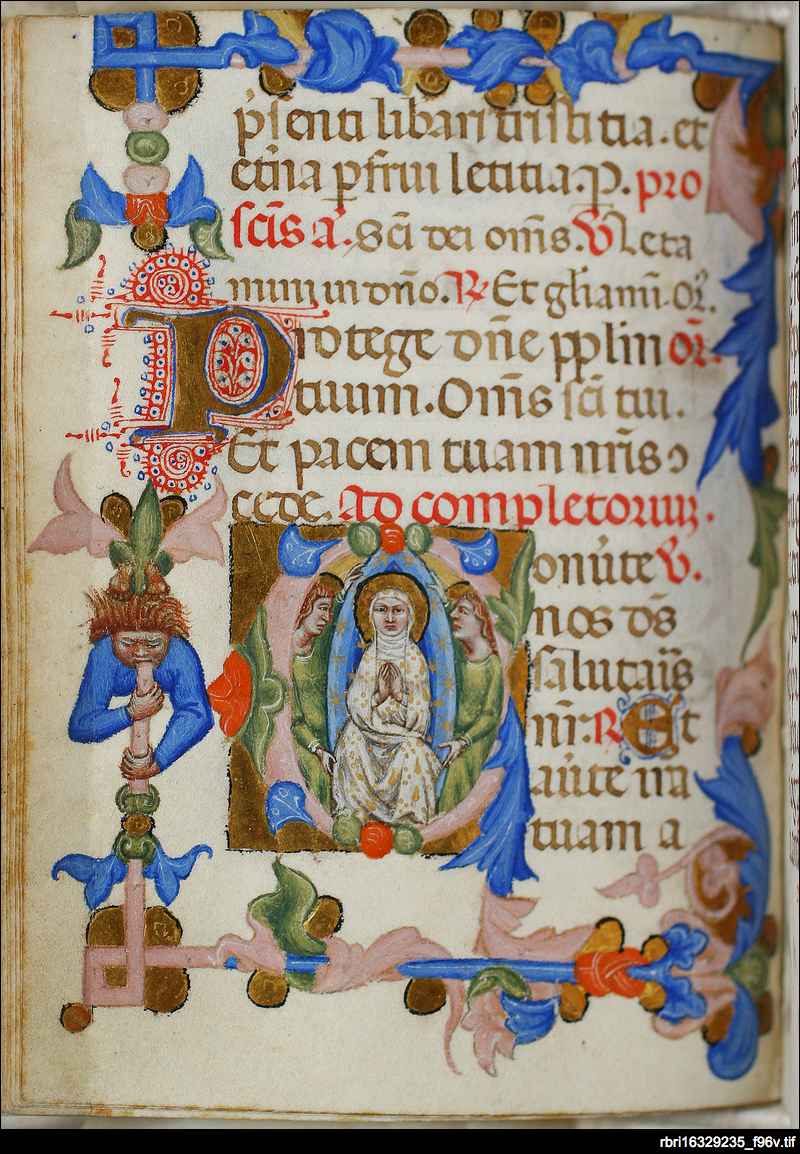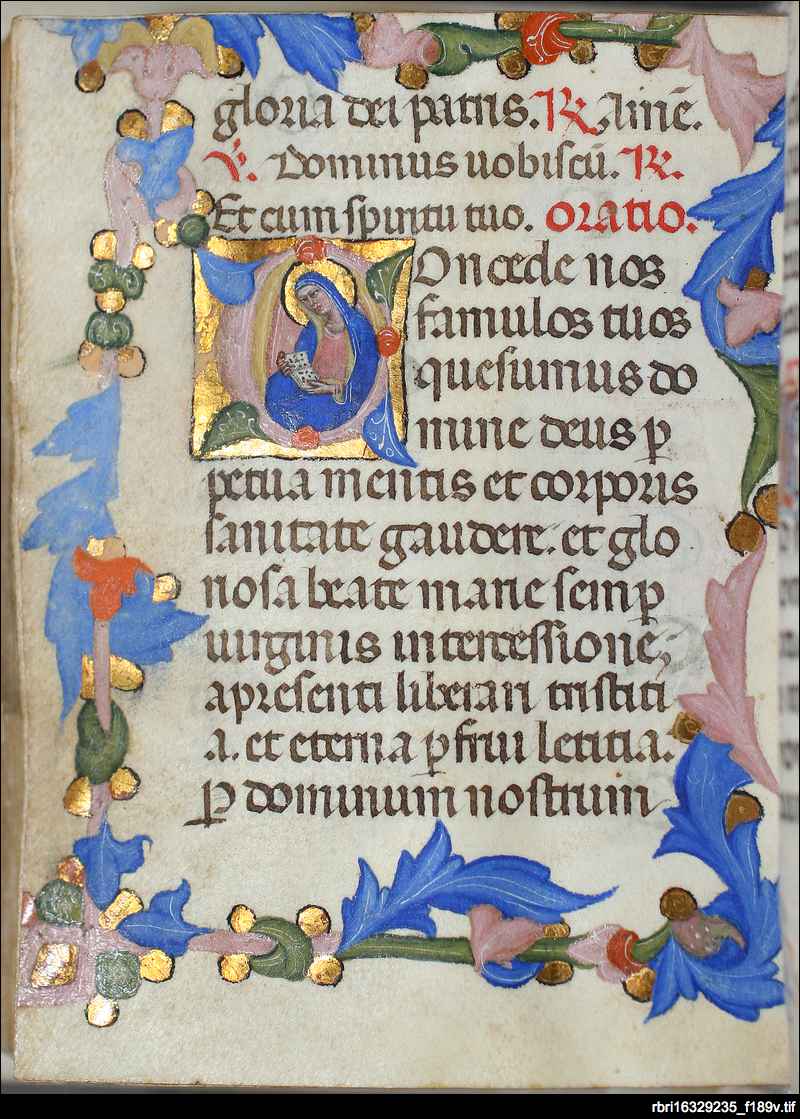
Adelaide's Hours
 Books of Hours
Books of Hours
In 1978 the Friends of the State Library of South Australia purchased a small manuscript prayer book, a Book of Hours, produced in the 14th century. Originally believed to have been created in France, a thorough examination of this manuscript some years later by Dr. Margaret Manion, University of Melbourne, determined that it had probably been created in central Italy. Since then the volume has been extensively examined and researched by Dr Bronwyn Stocks of Monash University. (Refer reading list below)
Books of Hours contained prayers and readings for the hours of the day prescribed for worship. They could be decorated in a manner befitting the wealth and position of the owner, and designed to the owner's taste. Books of Hours were personal prayer books, and usually small for portability so they could be turned to at the appropriate hour or moment wherever the owner might be in a domestic or public place without needing to go to a church. They could be used as a means of reaching out through prayer to the saints and to the Virgin Mary to request their intercession in the remission of sins. Contemplating the images within the book aided meditation and prayer.
The veneration of the saints was actively encouraged by the Church and precise calculations of spiritual debit and credit were a part of medieval life. Illustrations in Books of Hours and in altar pieces reveal the more popular saints who could be approached through prayer. Books of Hours illustrate the close intermeshing of the secular and spiritual life of the owner and the visual impact of the book reinforced the experience felt in reading the text. While the texts were standard and closely monitored by the Church the illumination and decoration were an expression of the artist, the region and of the commissioner or owner of the work itself.
Adelaide's Hours
'Stylistic influences from Perugia, Siena and Bologna are discernible in the manuscript's bold colouring, stocky figure types and heavy marginal decorations...;'
The medieval imagination: illuminated manuscripts from cambridge, Australia and New Zealand edited by Bronwyn Stocks and Nigel Morgan 2008 p. 184
Italian Books of Hours are less common than those from France, England and the Netherlands, particularly outside of Italy; this rarity and its near completeness, makes the State Library of South Australia's Italian Book of Hours (the Adelaide Hours) of especial significance. Regrettably there are no notes indicating the book's provenance or ownership. However it has been determined from its Calendar, with a reference to the Feast of St Mustiola of Chiusi on 3 July that the Book of Hours was created in or nearby that Tuscan town. Further, a votive Mass to St Catherine of Alexandria is included in the book which also points to Chiusi where catacombs are dedicated to both saints.
Italian Books of Hours are distinct from those produced north of the Alps. The use of historiated initials instead of miniatures is one characteristic, as is the focus on the illustration of the Office of the Dead and on the Passion, for instance two images in the Adelaide Hours are devoted to the Crucifixion. In the Adelaide Hours the historiated initial dominates the page; the extravagant border also uses much of the page with little room for text. The text fights for space. There is a focus on the human and personal, and on contemplation and emotive appeal.
The borders are of lavish acanthus foliage, frequently with birds including a lively rooster, and once, now partially obscured in the binding, a hoofed beast; several times a naked human figure emerges from the leaves and one stands clear at a corner. The Gothic border was a development of the late 12th and early 13th centuries, and used on the margins of the pages, allowed a greater interaction between the text and the illustration. In the Adelaide Hours the use of burnished gold is not restricted to the historiated initial but is used throughout the border decoration.
 In addition there are 19 thumb nail-sized historiated initials [initial capitals that contain a picture that is relevant to the particular passage] that are six lines high and which introduce the main sections of the book. These are very elaborate with foliate and knotted motifs, highlighted in white. The predominant colours are blue, yellow, orange, green and pink with a lavish use of burnished gold. These initials contain a story, usually a moment in the life of Christ or of his mother the Virgin Mary.
In addition there are 19 thumb nail-sized historiated initials [initial capitals that contain a picture that is relevant to the particular passage] that are six lines high and which introduce the main sections of the book. These are very elaborate with foliate and knotted motifs, highlighted in white. The predominant colours are blue, yellow, orange, green and pink with a lavish use of burnished gold. These initials contain a story, usually a moment in the life of Christ or of his mother the Virgin Mary.
The script is a rounded gothic hand in brown ink, and in addition to the historiated initials there are numerous one line initials in blue or gold with red or blue flourishes throughout the text. There are also two-line gold initials, many with detailed flourishes extending the length of the page.
 Basic text
Basic text
The basic text of a Book of Hours was the Little Office of Our Lady: prior to the 13th century this was usually attached to a Psalter (or book of psalms). By the mid-13th century the Book of Hours began to appear as a separate prayer book containing the Office of the Dead and the Hours of the Virgin. A devotion to the Virgin Mary began during the 10th century, and was given papal approval in the late 11th century. From the mid-13th century and the first known appearance of a separate Book of Hours the Virgin Mary had become the chief intercessor between man and God through her role as the mother of God.
The contents of a Book of Hours usually consisted of:
- Calendar: this would indicate the days of the Church feasts and saints' days. (The latter could include local saints which might assist the researcher in determining where a Book was created eg the Adelaide Hours makes reference to the feast day of St Mustiola of Chiusi (3 July) indicating a possible origin in Tuscany.)
- Hours of the Virgin: 'comprise an opening verse and response, followed by the Gloria, antiphon, psalms, capitula (short extracts from the Psalms), and hymns, divided by verses, responses and prayers or collects (orationes)'. (Harthan, p. 16)
- Hours of the Cross: consisting of only a hymn, antiphon and prayer but no psalms, lessons or responses. Italian Books of Hours often contain this text and/or the longer Office of the Passion: an indication of the intense devotion to Christ's Passion (death) in medieval Italy that was fostered especially by the Franciscan order.
- Penitential Psalms: a group of seven Psalms (6, 31, 37, 50, 101, 129 and 142) united thematically in their expression of profound sorrow and contrition for having sinned. These are traditionally attributed to the Old Testament King David and many Books of Hours contain illustrations depicting David composing or singing the Psalms.
- Litany of the Saints: this begins with the Greek invocation, kyrie eleison (Lord have mercy) followed by a list of saints, after each of which is the response, ora pro nobis (pray for us). The saints are arranged hierarchically into groups: angels and archangels; patriarchs and prophets; apostles, evangelists, disciples and innocents; martyrs; bishops, confessors and doctors; priests, clerics, monks and hermits; and virgins and widows.
- Office of the Dead: an essential part of the Books of Hours. Distinct from a Requiem Mass it consists of prayers said over the coffin during the nocturnal vigil before burial. The Office arose 'from the traditional Christian belief in the need for constant penitence and preparation before the inevitable Divine judgment.' (Harthan p. 17)
- Suffrages of the saints: Invocations, or short devotions of antiphon, verse, response and prayer beginning with the Trinity, followed by prayers to the Virgin Mary, St Michael, St John the Baptist, the Apostles and then other saints as determined by the wishes of the owner of the Book of Hours. The saints were prayed to as intercessors in the remission of sin. (Rarely in Italian books of hours)
- Prayers for a variety of purposes. A manuscript might for example, have prayers which the patron would recite to ward off the plague. Prayers to be read during Church services were also very popular.
Because Books of Hours were manuscript books usually ordered to the taste of the buyer/owner, no two are alike, and the order of the parts was not fixed except that the Calendar always came first.
Use of Books of Hours
'The main purpose of Books of Hours was to provide every class of the laity from kings and royal dukes down to prosperous burghers and their wives with personal prayerbooks ... Books of Hours were the vehicle both of intellectual Christianity at its loftiest and of popular devotion on the most primitive level.' (Harthan p. 31) It would be wrong to think that the richly illuminated Books of Hours were only objects to treasure, and not intended for use. There are many instances in the public record of the wealthy nobility taking the time to pray using their Book. Many Books of Hours bear the sign of that use, with missing pages, especially of the introductory Calendar, missing corners, smeared and stained pages from frequent use and the caresses of veneration. In the Adelaide Hours such signs of wear can be seen in the Calendar, and f.26r the Flagellation, where the edge of the page has been repaired and where the text is worn, f.93v The Nativity, general soiling along the edge of the page, f.117v Memento mori, general wear and f.124v Clerics praying over a death bed, also general wear. Both of these latter two instances may reflect the heavy use of these pages in the Book of Hours as the reader contemplated their life and the hereafter and prayed for the remission of their sins.
Books of Hours were treasured objects however, and their owners disposed of them with care, bequeathing them to children or other relatives in their wills. See Harthan Books of Hours page 33 for instances of this.
Acknowledgement is made to Dr Bronwyn Stocks, Monash University, for her assistance with this page.
Further reading:
Stocks, Bronwyn 'The Illustrated Office of the Passion in Italian Books of Hours' in The art of the book: its place in medieval worship edited by Margaret M. Manion and Bernard J. Muir Exeter: University of Exeter Press, 1998 pp. 111-152
Stocks, Bronwyn 'The Adelaide Hours: image, affect and devotion in a late fourteenth century Italian book of hours' in Imagination, the book and Communities in Medieval Europe Melbourne: Macmillan Art Press, 2009 (forthcoming)
De Hamel, Christopher A history of illuminated manuscripts Oxford: Phaidon, 1986
Harthan, John Books of hours and their owners London: Thames & Hudson, c1977
Manion, Margaret Medieval and Renaissance illuminated manuscripts in Australian collections by Margaret M. Manion and Vera F. Vines ; with a foreword by K.V. Sinclair Melbourne: Thames and Hudson, 1984 pp. 70-71
The medieval imagination: illuminated manuscripts from Cambridge, Australia and New Zealand edited by Bronwyn Stocks and Nigel Morgan South Yarra, Vic.: Macmillan Art Pub., 2008 pp.119-191
Wieck, Roger S Time sanctified: the Book of hours in medieval art and life New York: G. Braziller in association with the Walters Art Gallery, Baltimore, 1988
Items 13 - 21 of 21











